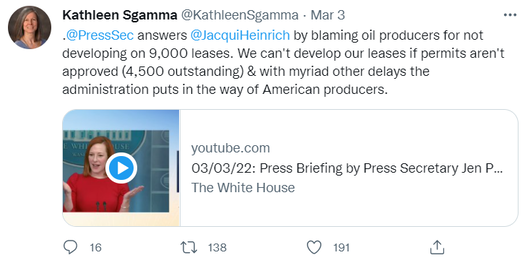.@PressSec answers @JacquiHeinrich by blaming oil producers for not developing on 9,000 leases. We can't develop our leases if permits aren't approved (4,500 outstanding) & with myriad other delays the administration puts in the way of American producers. https://t.co/RxPvqCySKW
— Kathleen Sgamma (@Wallstmemesteam) March 3, 2022
Wrote this quick blog post last Friday for all those who want to engage in a twitter war to deny what everyone knows: this administration's hostile policies have suppressed American oil production. https://t.co/e4eLLjE6Hz pic.twitter.com/KCxtL82x5k
— Kathleen Sgamma (@Wallstmemesteam) March 7, 2022
Kathleen Sgamma, the President of WesternEnergy1. Western Energy Alliance, “The Voice of the Oil & Natural Gas Industry in the West”
https://www.westernenergyalliance.org/blog/responding-to-the-white-house-blame-game-on-leases
Responding to the White House Blame Game on Leases
March 4, 2022
On Thursday, White House Press Secretary Jen Psaki, in response to a question about increasing domestic oil production, attempted to shift the blame to oil companies by citing “9,000 approved oil leases that the oil companies are not tapping into currently.”
While we may not appreciate the cynical attempt to deny the effects of the president’s own “no federal oil” policies, we appreciate that the White House suddenly wants American producers to develop on federal lands. After the Biden Administration spent over a year making it more difficult to develop on federal lands while begging Russia to increase its production, the admission—no matter how long it took to make—that American production is preferable to Russian is now welcome.
We also appreciate that suddenly environmental groups are very keen for us to develop on existing leases and permits, as they constantly sue to stop any development. They spent the better part of Friday attempting to help the administration shift blame by quoting numbers of permits in response to my tweet.
As federal oil and natural gas is a highly complex system and with only 280 characters available in Twitter, let me take this opportunity to provide some insight into the numbers and the “myriad other delays the administration puts in the way of American producers.”
|
First the 9,000 leases that Psaki cited. There are about 37,496 leases in effect. Assuming her number is correct on nonproducing leases (as the administration doesn’t have FY 2021 data on its oil and gas statistics page even five months after the FY ended), 76% is a very high lease utilization rate.
|
|
-
- Companies must develop a complete leasehold before permitting can occur, particularly with the long horizontal wells that can cut across multiple leases. Sometimes a new lease is needed to combine with existing leases to make a full unit. Since the Biden leasing ban remains in effect with no onshore lease sales held since 2020, some leases are held up waiting for new leases or for the government to combine them into a formal unit.
- Before allowing development on leases, the government conducts environmental analysis under NEPA (the National Environmental Policy Act) that often takes years to complete. Many leases can be hung up in that process or awaiting other government approvals.
- Finally, not all leases will be developed because, after conducting exploratory work, a company may determine there are not sufficient oil and natural gas resources on them. The country still benefits from the leasing revenue paid on the leases.
Let’s talk permits. There are 4,621 permits to drill awaiting approval. By approving these permits in a timely manner, companies could move forward with development. There are also about 9,173 permits approved and available to drill.
- Because of the uncertainty of operating on federal lands, companies must build up a sufficient inventory of permits before rigs can be contracted to ensure the permits stay ahead of the rigs. We drill wells in a matter of days and rigs are very expensive, so it’s a delicate balancing act. But there are other things that can delay a company from developing a well right away.
- The federal permit to drill is not the only government approval required. Rights of way must be acquired to access the lease and for natural gas gathering systems. ROWs can take years to acquire. With the pressure not to flare from regulators and investors, most companies cannot drill before the gathering lines are in place. Timely approvals of ROWs would enable companies to develop sooner.
- The administration has worked with anti-oil-and-gas activists to slow pipeline infrastructure. Without pipelines to move the oil and natural gas produced, wells cannot be developed.
- Capital must be acquired. Activist investors, encouraged by an administration using its regulatory powers, have worked to de-bank and de-capitalize the oil and natural gas industry. Many companies, particularly the small independents who drill the majority of federal wells, are having difficulty acquiring the capital necessary to develop. By calling off bureaucratic efforts to deny lending to the industry, the president would send a strong signal to the market that investments in oil and natural gas are safe and more development would move forward.
- The Biden Administration has embarked on an agenda of regulatory overreach with extensive new regulations in the works. The uncertainty of all the new red tape puts a damper on new investment and development today, especially on federal lands where the burden is highest. Consequently, companies prioritize their nonfederal leases because there’s less regulatory risk.
These are just some of the political and bureaucratic obstacles this administration is engaging in to slow American production. Please see my op-eds in the Washington Examiner and The Hill for ideas on how the president could encourage American oil and natural gas production rather than just try to shift the blame.
| Position Paper: Who’s to Blame for High Energy Prices |
#
Key Points:
While we may not appreciate the cynical attempt to deny the effects of the president’s own “no federal oil” policies, we appreciate that the White House suddenly wants American producers to develop on federal lands. After the Biden Administration spent over a year making it more difficult to develop on federal lands while begging Russia to increase its production, the admission—no matter how long it took to make—that American production is preferable to Russian is now welcome.
We also appreciate that suddenly environmental groups are very keen for us to develop on existing leases and permits, as they constantly sue to stop any development.
Many leases are held up in litigation by environmental groups. Western Energy Alliance is in court defending over 2,200 leases, most of which cannot be developed while those cases wind their way through the courts.
Before allowing development on leases, the government conducts environmental analysis under NEPA (the National Environmental Policy Act) that often takes years to complete. Many leases can be hung up in that process or awaiting other government approvals.
Finally, not all leases will be developed because, after conducting exploratory work, a company may determine there are not sufficient oil and natural gas resources on them. The country still benefits from the leasing revenue paid on the leases.
There are 4,621 permits to drill awaiting approval. By approving these permits in a timely manner, companies could move forward with development. There are also about 9,173 permits approved and available to drill.
Because of the uncertainty of operating on federal lands, companies must build up a sufficient inventory of permits before rigs can be contracted to ensure the permits stay ahead of the rigs. We drill wells in a matter of days and rigs are very expensive, so it’s a delicate balancing act.
The administration has worked with anti-oil-and-gas activists to slow pipeline infrastructure. Without pipelines to move the oil and natural gas produced, wells cannot be developed.
The Biden Administration has embarked on an agenda of regulatory overreach with extensive new regulations in the works. The uncertainty of all the new red tape puts a damper on new investment and development today, especially on federal lands where the burden is highest.
Activist investors, encouraged by an administration using its regulatory powers, have worked to de-bank and de-capitalize the oil and natural gas industry.



